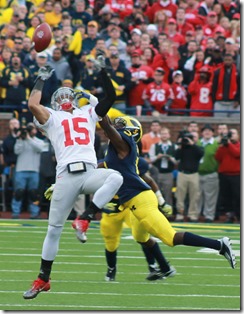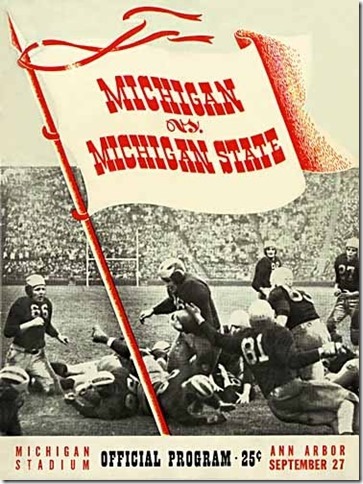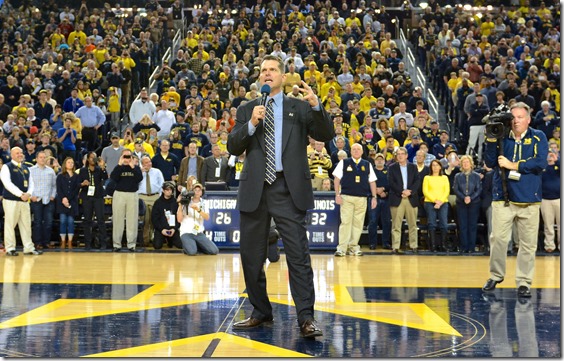michigan state is big daddy
[Ed-Seth: Dr. Sap found the archival footage at 2 a.m. last night and we threw this together today]
[via UM Bentley Library’s program database, which is currently offline for some reason]
If you think Michigan State and Michigan hate each other now, you should see how ugly it got 75 years ago. Michigan and Michigan Agricultural formed an early rivalry. It was a big enough deal by 1907 that when the Big Ten banned its members from playing nonconference games, Yost (for this and other reasons) preferred to remove Michigan from the conference entirely rather than agree to never play Michigan State, Ohio State, or Notre Dame (or in a Rose Bowl) ever again.
The series was of course dominated by (and nearly always played at) Michigan but for a four-year stretch from 1934-’37. 1930s-40s MSC was the Ole Miss of its day. In a time when conferences did most of the (and not a particularly great job of) regulating amateurism, State’s non-conference affiliation was a massive loophole. Jim Crowley, one of Notre Dame’s “four horsemen” and his successor, another Domer named Charlie Bachman, brazenly flouted NSC (the predecessor to the NCAA) rules to put MSC on the national stage. Michigan fans, of course, pointed this out at every opportunity, though Harry Kipke was no saint before Yost finally reined him in (Michigan went 12-22 after winning back to back national championships in ’32 and ’33).
Fast forward to September 1941. With Europe deeply embroiled in World War II and the United States feeling the inevitability of getting drawn in, tensions were quite high, not just around the world, but in the state of Michigan. It’s a huge and probably false step to claim that Michigan-Michigan State mirrored the urban/rural political battles of the day; it’s not one to say that a lot of fans on both sides perceived reasons to hate each other.
Although Pearl Harbor was yet a few months in the future, despite strong political opposition from a largely anti-war nation, America had begun its mobilization. Students and players were already enlisting, and football players were allowed to transfer between schools (with immediate eligibility) to assist those colleges and academies. Already the great football programs of the 1930s were hemorrhaging men to the military. Army went 1-7-1 in 1940; in 1941 they went 5-3-1 and tied Notre Dame. In just a few years the service academies would be perennial national powers and Michigan State wouldn’t even field a football team.
On September 4, 1941, a German U-Boat, unprovoked, fired upon the USS Greer. A week later, President Roosevelt declared any German warship in “waters which America deems vital to its defense” to be fair game, and ordered the U.S. Navy to shoot any perceived threat on sight. On Friday, September 26th, the Military Police Corps was founded. On Saturday the 27th, Michigan hosted Michigan State College.
With the game tied 7-7 at the half, things got a little ugly as it appears that some of the fans and students poured onto the Michigan Stadium field and decided to mill around. One thing led to another and before you knew it, a donny-brook ensued! Fisticuffs and haymakers were thrown and then it was all out bedlam. It looked like this:
(found this on one of my DVDs)
Michigan ended up winning the game, 19-7.
-------------------------------
Much changed in the following year. The U.S. entered war on December 7, and opposition quickly melted into patriotic duty. The students and players were enlisting and football players were allowed to transfer between schools to assist those colleges and academies that were supporting the war effort. Michigan successfully lobbied to be one of those host schools.
From Brian Williams at the Bentley Historical Library:
"Football was a sport short on manpower, even with significantly relaxed eligibility rules. Many colleges were forced to drop intercollegiate football during the war, including Michigan State, which canceled its 1943 season."
"The government even asked Michigan to consider moving its games to Detroit for the 1942 season to conserve resources. As Michigan prepared to play its first wartime season in 1942, the application sent to prospective players reflected the new reality. The application asked candidates if they were registered under the Selective Service Act, what their classification was, and most important for the coaching staff, “When do you expect to be called?”
"One significant change for the 1942 football season was an overhaul of eligibility rules. Prompted by a loss of manpower through enlistment and the Selective Service draft, the freshman eligibility rule was waived. The rule revision that allowed freshmen to play also enabled soldiers and sailors stationed at military training bases to be eligible regardless of their previous experience. Many of the players on the military base teams had completed their college eligibility and a few had even played professionally."
Both teams once again squared off in Ann Arbor, literally and figuratively. Despite Michigan benefitting from the same wartime transfers that were ravaging MSC, the game was just as close as the year before, with the halftime score knotted at 0-0.
It seems like the students and fans once again poured onto the field, but this time things started out a little more amicably.
After trying to perform some sort of locomotion script, emotions got the best of everyone, even as the Michigan State band tried to continue their halftime performance.
Some of the Michigan cheerleaders tried to get everyone to chill, but to no avail.
The scene was this:
Michigan once again was the victor, winning the football game, 20-0.
The following year, with so many young men leaving East Lansing for more patriotic pursuits, Michigan State didn’t even field a football team, and the rivalry settled down.
Just seven members of the 1942 squad would still be in Ann Arbor by 1943, however they were replaced by an embarrassment of other teams’ riches coming to Michigan to train in the Navy’s V-12 program on campus. Among them were Minnesota star Bill Daley, and ten players from Wisconsin, including All-American Elroy “Crazy Legs'” Hirsch.
After the War, State dramatically expanded to accommodate G.I. Bill students. In 1947 they hired Biggie Munn, one of the pioneers in national recruiting, who quickly turned the rechristened Michigan State University Spartans back into a national elite. The Spartans would join the Big Ten in 1953 and Michigan’s star would fade for decades.
So while we celebrate the 75th anniversary of "The 1942 Backyard Brawl," let's try and have cooler heads prevail—especially with Saturday's game being played at night.
Fuller
The Question:
Ace: When do you expect Michigan to get on level footing with Michigan State and Ohio State? Do you expect them to, in the latter case?
-----------------------------------
The Answers:
Dave Nasternak: Well, those are 2 different levels, especially after the last year.
As far as reaching Michigan State's level, I'm thinking (hoping?) Harbaugh will get them to that level in the next 2-3 years. I actually think that the talent differential is not huge, outside of a couple of obvious positions. The coaching differential, however...has been quite large. One of the interesting things about Michigan State has been their recruiting. They have not had stand-out, elite level recruiting during their stretch of dominance over Michigan (and kinda the Big Ten). But they have developed their roster as well as anyone has...which is coaching. It has also not hurt Michigan State that Michigan and Penn State have not been at program expectations over the past 5+ years. However, with Harbaugh in Ann Arbor, now -and a competitively talented roster to work with- I think that gap has already shrunk a bit...and will presumably do so in the next couple of years.
 |
| You will NOT take away the year of Fickell. [Upchurch] |
Since the end of the 2004 season, Ohio State is 110-21. 104-14 if you take away the Year of Fickell. That's...uh...I don't even know. I definitely think this past 10 or so years has not been the Big Ten's best -definitely some under-performing teams and questionable hiring decisions by a few of the schools- but...yikes, man. There were a few years where its felt like Michigan has lost 14 games...just in that year, alone! I'm not sure anyone is going to THAT level, any time soon. If anyone can give Michigan a chance to do so, it would be Jim Harbaugh, though. Anyway...my next point, haha. One of the things that Ohio State has that has eluded most of the Big Ten teams (at least lately) is a game-changer. And they have had many. Going back to Troy Smith, Terrelle Pryor and now Miller/Barrett/Jones and Elliott. These are guys that can score every time they touch the ball...and always seem to make a play to keep a drive alive or score when OSU needs points. They are Heisman trophy winners...or at least candidates. That is level of recruit AND development that Michigan is going to need in order to compete at the OSU level. Can and will Harbaugh take Michigan there? I think he can. I hope he will. When? It will be years before he will be able to make a mark like OSU has been able to over the last decade or so. But I do think that once Harbaugh gets Top 100/300/whatever recruits flowing into his system, Michigan will be able to go toe-to-toe with Ohio State and at least beat them at a competitive rate...instead of the 1(Fickell) and 10 it has been over the past 11 years.
[After the jump: projections on a sophomore roster]


28